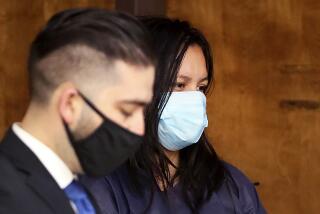3 Infants Die, Mother Faces Trial : SIDS: Illinois woman is accused of smothering her children. Experts say three such deaths in one family would be extraordinary; but, statistically, one such death in family boosts chances of a repeat.
- Share via
CHICAGO — A mother’s arrest on charges she killed her three babies--deaths that first appeared to be sudden infant death syndrome--raises a disturbing question: How many SIDS deaths are really homicides?
Experts say the answer is unknowable.
Illinois authorities said they took pains to eliminate other possibilities before concluding that 30-year-old Gail Savage must have killed her children.
On Sept. 9 prosecutors said they charged Savage with three counts of first-degree murder after she admitted suffocating all three of her infants with a blanket while her husband was at work.
Savage, who lives in Wauconda, about 30 miles northwest of Chicago, has no other children.
She pleaded not guilty at her preliminary hearing last week and is being held without bail. The prosecution said it does not intend to request the death penalty.
While the justice system seeks the truth about the Savage babies, it will likely confront the medical enigma called SIDS.
Also known as crib death or cot death, sudden infant death syndrome strikes about one in every 500 babies in the United States, making it the most common cause of death among infants 2 weeks to 12 months old. Seemingly healthy babies die without warning, often in their sleep.
Dr. Marie Valdes-Dapena, a pediatric pathologist at the University of Miami, estimates that no more than 2% of SIDS cases are really slayings.
Others have put the proportion higher, as much as 10%, she noted in a recent interview.
“Personally, I think that’s an exaggeration,” said Valdes-Dapena, who has done hundreds of autopsies on SIDS victims, has talked with “lots and lots of parents” and was a consultant on the Savage case.
SIDS, by definition, means the infant’s death cannot be explained, even after an autopsy, a police investigation and a review of family medical history.
“In reality, SIDS is not a diagnosis,” said Dr. Alfred Steinschneider, a longtime SIDS researcher and founder of the American SIDS Institute in Atlanta. “It’s a category of ‘I don’t know.’ ”
The category was created by the National Institute of Child Health and Human Development.
Research has shown that certain biological abnormalities are present in most SIDS victims, Valdes-Dapena said.
The abnormalities, typically a little extra blood and fluid in the lungs and a slight hemorrhaging in the thymus gland, are not specific to SIDS, however. They occur in some explainable deaths as well, Valdes-Dapena said.
Making matters more difficult, as in the Savage case, SIDS cannot be distinguished from suffocation with a soft blanket or pillow, she said.
Six-week-old Michael Savage was the first of Gail Savage’s children to die, in November, 1990. The coroner initially attributed the boy’s death to SIDS. Then in February, 1992, 22-day-old Amber died of unknown causes, followed by 5-month-old Cynthia’s unexplained death on June 28 this year.
Savage and her husband, James Savage, a 36-year-old carpenter, had said they believed the infants died of SIDS or a genetic defect.
The husband, whom prosecutors do not consider a suspect, has insisted the authorities are wrong.
“Because they can’t explain these deaths, and there were three of them, they don’t want to believe they were SIDS deaths,” he told the Chicago Tribune. “This is tearing me apart because in my heart, I really believe they were SIDS deaths.”
At Gail Savage’s first court hearing, the prosecutor cited Valdes-Dapena’s estimate that the probability of three SIDS deaths occurring in a single household was “infinitesimal, probably impossible.”
But in her interview with the Associated Press, Valdes-Dapena said, “It’s uncommon to have two, and it is really uncommon to have three.”
That doesn’t rule out three SIDS deaths in one family, said Steinschneider, the SIDS researcher in Atlanta.
Research has shown that a family that loses a baby to SIDS is five to 10 times more likely than the general population to lose another one to SIDS, he said.
Every year in the United States, the deaths of 7,000 to 8,000 babies are classified as SIDS cases, but no one keeps statistics on how many occur in families that already had one SIDS death, Steinschneider said.
More to Read
Sign up for Essential California
The most important California stories and recommendations in your inbox every morning.
You may occasionally receive promotional content from the Los Angeles Times.









